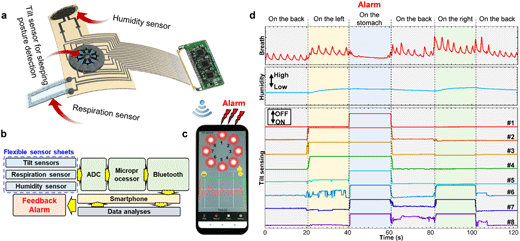| Mar 31, 2021 | |
A wearable, wireless feedback sensor system to track body conditions |
|
| (Nanowerk Spotlight) Vulnerable groups in society, such as the disabled, elderly, and infants, often require special care and are at risk of severe illness or even death. For example, each year around the world, over 3 million infants die within the first year of life. | |
| A leading cause of infant mortality is 'sudden infant death syndrome' (SIDS), which is primarily attributed to a prone – i.e., face down – sleeping position. Infants in a prone position are susceptible to accidental suffocation chiefly due to a respiratory infection or a lack of oxygen. Therefore, the desired sleeping posture is to place infants on their backs. | |
| Another factor to maintain the sleeping quality of infants is the diaper change frequency. Conventional strategies to monitor the sleeping status rely on live-streaming videos or inflexible chip sensors. However, these methods often lag or have relatively poor wearing comfort. | |
| Wearable flexible sensors have recently emerged as promising alternatives for human healthcare monitoring due to their lightweight and thin-film-based nature. In the past decade, various flexible physical and chemical sensors have been conceived and demonstrated to track human physical activities, vital signs, or biofluid information. | |
| However, few of these flexible sensor systems are applicable to neonatal monitoring, especially sleeping posture detection. Hence, additional efforts are required to exploit innovative sensor configurations to monitor vulnerable populations. | |
| In a recent study published in Advanced Materials ("A Wearable Body Condition Sensor System with Wireless Feedback Alarm Functions"), researchers from Osaka Prefecture University report a versatile laser-induced graphene (LIG)-based integrated sensor system, which can wirelessly monitor sleeping postures, respiration rate, and diaper wetness with feedback alarm functions. | |
| To realize such an integrated sensor system, one of the most challenging tasks is to develop a wearable tilt sensor, which is less studied in wearable electronics. The authors demonstrate a new type of tilt sensor, consisting of only soft materials. | |
| The core of this design is the confinement of a liquid metal droplet inside a nonstick elastomeric cavity, which is homogeneously surrounded by eight pairs of functionalized electrodes, allowing to monitor at least 18 slanting orientations. | |
 |
|
| A wearable feedback multimodal wireless sensing system for vulnerable groups’ monitoring. (a) Schematic of multi-modal wireless flexible sensor system. (b) Block diagram of the wearable device integrated with signal processing, wireless transmission, and feedback alarm functions. (c) Photo of the wireless monitoring results on a smart phone. (d) Wireless real-time monitoring results measured from an adult lying on a mattress. (Image courtesy of the researchers) (click on image to enlarge) | |
| "Liquid metals have many distinct merits, including fluidity, softness, stretchability, and high thermal/electrical conductivity," said Prof. Michael D. Dickey, an international pioneer in the research of liquid metals. "They also adhere readily to most surfaces. Based on the approach of laser processing, Xu et al. made a breakthrough in developing a soft platform that not only exhibits no adhesion to liquid metal, but also achieves well-defined conductive patterns. Such a functional matrix should expand the applications of liquid metals." | |
| "The majority of wearable physical and chemical sensors are applied to track human physical activities, vital signs, or biofluid information," said Prof. Wei Gao, an expert on flexible bioelectronics from California Institute of Technology. "The flexible sensor system with feedback functions for timely-decision could have a significant impact on remote and wireless monitoring of vulnerable populations." | |
| Prof. Kaichen XU, first author of the publication and currently a ZJU-100 professor at Zhejiang University emphasized that "using advanced laser manufacturing as a primary fabrication means, we are able to create sensitive nanomaterials, modulate surface wettability as well as realize interconnected electrodes. These elements contribute to the formation of integrated sensor systems." | |
| "We employ a rapid and scalable laser direct writing method coupled with an additive manufacturing technique to realize LIG patterning in both the in-plane and out-of-plane configurations as well as the formation of nonstick conductive structures to the liquid metal," said Prof. Kuniharu Takei, the corresponding author of the publication. "In addition, our proposed multimodal sensor system has almost no signal cross-sensitivity effect." | |
| Future tasks for the research team include integration of extra sensing modules into the thin-film-based flexible sensor system to comprehensively track skin temperature, heart and pulse rates, oximeters, and other health vital signs. With regard to safety issues, the scheme of battery-free wireless circuits should be involved in multimodal flexible sensor systems using strategies such as near-field communication, magnetic resonant coupling, or energy harvesting. | |
| In conclusion, an all-in-one wireless sensor system with superior mechanical compliance and prolonged monitoring capability are very promising for feedback closed-loop hybrid flexible sensor systems. | |
| Provided by Department of Physics and Electronics, Osaka Prefecture University State Key Laboratory of Fluid Power and Mechatronic Systems, School of Mechanical Engineering, Zhejiang University, as a Nanowerk exclusive | |
|
Become a Spotlight guest author! Join our large and growing group of guest contributors. Have you just published a scientific paper or have other exciting developments to share with the nanotechnology community? Here is how to publish on nanowerk.com. |
|
